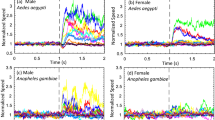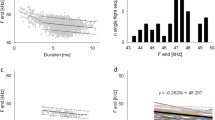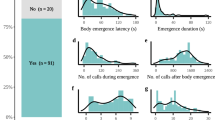Abstract
We presented free-flying locusts (Locusta migratoria L.) with sounds that varied in temporal structure and carrier frequency as they flew toward a light source in a flight room under controlled temperature and light conditions. Previous studies have shown tethered locusts react more often to trains of 30-kHz pulses than to pulse trains below 10 kHz. Further, this acoustic startle response has been suggested to function in bat-avoidance. We expected free-flying locusts to respond similarly; however, we found locusts responded to all sounds we presented, not just high-frequency, “bat-like” sounds. Response rates of turns, loops, and dives varied from 6% to 26% but were statistically independent of carrier frequency and/or pulse structure. Free-flying moths and tethered locusts were tested using a subset of our acoustic stimuli under the same temperature and light conditions as the free-flying locusts. Moth responses were carrier frequency dependent as were responses of tethered locusts positioned along the flight path observed in our free-flight trials. All responses were unaffected by a 90% reduction in room light. We conclude that locusts possess an acoustic startle response evocable in free flight, however, free-flying locusts do not show the same discrimination observed in tethered locusts under similar conditions.







Similar content being viewed by others
Abbreviations
- ASR:
-
acoustic startle response
- dB SPL:
-
decibel sound pressure level (RMS re: 20 μPa)
References
Baader A (1991) Auditory interneurons in locusts produce directional head and abdomen movements. J Comp Physiol A 169:87–100
Baader A, Schäfer M, Rowell CHF (1992) The perception of the visual flow field by flying locusts: A behavioural and neuronal analysis. J Exp Biol 165:137–160
Barclay RMR, Brigham RM (1991) Prey detection, dietary niche breadth, and body size in bats: why are aerial insectivorous bats so small? Am Nat 137:693–703
Barclay RMR, Brigham RM (1994) Constraints on optimal foraging: a field test of prey discrimination by echolocating insectivorous bats. Anim Behav 48:1013–1021
Bauer R (1993) Untersuchung zur Anlockung von nachtaktiven Insekten durch Beleuchtungseinrichtungen. Diploma thesis, University of Konstanz
Belwood JJ, Morris GK (1987) Bat predation and its influence on calling behaviour in neotropical katydids. Science 238:64–67
Brower LP, Calvert WH (1985) Foraging dynamics of bird predators on overwintering monarch butterflies in Mexico. Evolution 39:852–868
Calvert WH, Hedrick LE, Brower LP (1979) Mortality of the monarch butterfly (Danaus plexippus L.): avian predation at five overwintering sites in Mexico. Science 204:847–851
Chapman RF (1976) A biology of locusts. Edward Arnold, London
Dawson JW, Dawson-Scully K, Robert D, Robertson RM (1997) Forewing asymmetries during auditory avoidance in flying locusts. J Exp Biol 200:2323–2335
Doherty J, Hoy R (1985) Communication in insects. III. The auditory behaviour of crickets: some views of genetic coupling, song recognition, and predator detection. Q Rev Biol 60:457–472
Farrow RA (1990) Flight and migration in acridoids. In: Chapman RF, Joern A (eds) Biology of grasshoppers. Wiley, New York, pp 227–314
Faure PA, Hoy RR (2000) The sounds of silence: cessation of singing and song pausing are ultrasound-induced acoustic startle behaviors in the katydid Neoconocephalus ensiger (Orthoptera; Tettigoniidae). J Comp Physiol A 186:129–142
Fenton MB, Bell GP (1981) Recognition of species of insectivorous bats by their echolocation calls. J Mammal 62:233–243
Fenton MB, Bell GP, Thomas DW (1980) Echolocation and feeding behaviour of Taphozous mauritianus (Chiroptera: Emballonuridae). Can J Zool 58:1774–1777
Forster W, Wohlfahrt TA (1960) Die Schmetterlinge Mitteleuropas. Band III. Spinner und Schwärmer (Bombyces und Sphinges). Franckh’sche Verlagshandlung. Keller, Stuttgart
Forster W, Wohlfahrt TA (1971) Die Schmetterlinge Mitteleuropas. Band IV. Eulen (Noctuidae). Franckh’sche Verlagshandlung. Keller, Stuttgart
Forster W, Wohlfahrt TA (1981) Die Schmetterlinge Mitteleuropas. Band V. Spanner (Geometridae). Franckh’sche Verlagshandlung. Keller, Stuttgart
Freeman PW (1981) Correspondence of food habits and morphology in insectivorous bats. J Mammal 62:166–173
Fullard JH (1988) The tuning of moth ears. Experientia 44:423–428
Fullard JH, Dawson JW (1999) Why do diurnal moths have ears? Naturwissenschaften 86:276–279
Fullard JH, Yack JE (1993) The evolutionary biology of insect hearing. Trends Ecol Evol 8:248–252
Gatehouse AG, Zhang XX (1995) Migratory potential in insects: variation in an uncertain environment. In: Drake VA, Gatehouse AG (eds) Insect migration: tracking resources through space and time. Cambridge University Press, London, pp 193–242
Hager MC, Helfman GS (1991) Safety in numbers: shoal size choice by minnows under predatory threat. Behav Ecol Sociobiol 29:271–276
Haskell PT (1957) The influence of flight noise on the behaviour in the desert locust Schistocerca gregaria (Forsk.). J Insect Physiol 1:52–75
Hedwig B (1988) Modulation of auditory information processing in tethered flying locusts. J Comp Physiol A 164:409–422
Hoy RR (1989) Startle, categorical response, and attention in acoustic behavior of insects. Annu Rev Neurosci 12:355–377
Hoy RR (1992) The evolution of hearing in insects as an adaptation to predation from bats. In: Webster DB, Fay RR, Popper AN (eds) The evolutionary biology of hearing. Springer, Berlin Heidelberg New York, pp 115–129
Hoy RR, Robert D (1996) Tympanal hearing in insects. Annu Rev Entomol 41:433–450
Hoy RR, Nolan T, Brodfuehrer P (1989) The neuroethology of acoustic startle and escape in flying insects. J Exp Biol 146:287–306
Kalmring K (1975) The afferent auditory pathway in the ventral cord of Locusta migratoria (Acrididae). II. Responses of the auditory ventral cord neurons to natural sounds. J Comp Physiol 104:143–159
Kennedy JS (1956) Phase transformation in locust biology. Biol Rev 31:349–370
Kingdon J (1974) East African mammals: an atlas of evolution in Africa, vol II, part A (insectivores and bats). University of Chicago Press, Chicago
Kutsch W (1999) Telemetry in insects: the “intact animal approach”. Theor Biosci 118:29–53
Kutsch W, Fuchs U (2000) Locust flight initiation: a comparisons of normal and artificial release. Physiol Entomol 25:370–382
La Val RK, La Val ML (1980) Prey selection by a neotropical foliage-gleaning bat, Micronycteris megalotis. J Mammal 61:327–330
Lewis FP, Fullard JH, Morrill SB (1993) Auditory influences on the flight behaviour of moths in a Nearctic site. II. Flight times, heights, and erraticism. Can J Zool 71:1562–1568
Libersat F, Hoy RR (1991) Ultrasonic startle behavior in bushcrickets (Orthoptera; Tettigoniidae). J Comp Physiol A 169:507–514
Miller LA, Olesen J (1979) Avoidance behavior in green lacewings. I. Behavior of free flying green lacewings to hunting bats and ultrasound. J Comp Physiol 131:112–120
Moiseff A, Hoy RR (1983) Sensitivity to ultrasound in an identified auditory interneuron in the cricket: a possible neural link to phonotactic behavior. J Comp Physiol 152:155–167
Moiseff A, Pollack G S, Hoy RR (1978) Steering responses of flying crickets to sound and ultrasound: mate attraction and predator avoidance. Proc Natl Acad Sci USA 75:4052–4056
Morrill SB, Fullard JH (1992) Auditory influences on the flight behaviour of moths in a Nearctic site. I. Flight tendency. Can J Zool 70:1097–1101
Nolen TG, Hoy RR (1986) Phonotaxis in flying crickets. I. Attraction to the calling song and avoidance of bat-like ultrasound are discrete behaviours. J Comp Physiol A 159:423–439
Pollack GS, Hoy RR (1981) Phonotaxis in flying crickets: neural correlates. J Insect Physiol 27:41–45
Pollack GS, Hoy RR (1989) Evasive acoustic behavior and its neurobiological basis. In: Huber F, Moore T, Loher W (eds) Cricket behaviour and neurobiology. Cornell University Press, Ithaca, New York, pp 340–363
Pollack GS, Huber F, Weber T (1984) Frequency and temporal patter-dependent phonotaxis of crickets (Teleogryllus oceanicus) during tethered flight and compensated walking. J Comp Physiol A 154:13–26
Riley JR, Reynolds DR (1997) Vertical-looking radar as a means to improve forcasting and control of desert locusts. In: Krall S, Peveling R, Ba Diallo D (eds) New strategies in locust control. Birkhäuser, Basel, Switzerland, pp 47–54
Robert D (1989) The auditory behaviour of flying locusts. J Exp Biol 147:279–301
Robert D, Rowell CHF (1992) Locust flight steering. II. Acoustic avoidance manoeuvres and associated head movements, compared with correctional steering. J Comp Physiol A 171:53–62
Roeder KD (1962) The behaviour of free flying moths in the presence of artificial ultrasonic pulses. Anim Behav 10:300–304
Roeder KD (1964) Aspects of the noctuid tympanic nerve response having significance in the avoidance of bats. J Insect Physiol 10:529–546
Roeder KD (1967) Nerve cells and insect behaviour. Harvard University Press, Cambridge, MA
Roeder KD (1974) Acoustic sensory responses and possible bat-evasion tactics of certain moths. Proceedings of the Canadian Society of Zoologists Annual Meeting, pp 71–78
Rydell J, Skals N, Surlykke A, Svensson M (1997) Hearing and bat defence in geometrid winter moths. Proc R Soc Lond Ser B 264:83–88
Sales G, Pye D (1974) Ultrasonic communication by animals. Chapman & Hall, London
Simmons JA, Fenton MB, O’Farrell MJ (1979) Echolocation and pursuit of prey by bats. Science 203:16–21
Spork P, Preiss R (1991) Control of flight by means of lateral visual stimuli in the desert locust, Schistocerca gregaria. In: Elsner N, Penzlin H (eds) Synapse-transmission-modulation. Proc 19th Göttingen Neurobiol Conf. Thieme, Stuttgart
Stapells DR, Picton TW, Smith AD (1982) Normal hearing thresholds for clicks. J Acoust Soc Am 72:74–79
Surlykke A, Filskov M (1997) Hearing in geometrid moths. Naturwissenschaften 84:356–359
Surlykke A, Moss CF (2000) Echolocation behaviour of big brown bats, Eptesicus fuscus, in the field and laboratory. J Acoust Soc Am 108:2419–2429
Svensson AM, Rydell J (1998) Mercury vapour lamps interfere with the bat defense of tympanate moths (Operophtera spp.; Geometridae). Anim Behav 55:223–226
Sweeney BW, Vannote RL (1982) Population synchrony in mayflies: a predator satiation hypothesis. Evolution 36:810–821
Uvarov BP (1943) The locust plague. J R Soc Arts 91:109–118
Uvarov BP (1966) Grasshoppers and locusts: a handbook of general acridology, vol 1. Anatomy, physiology, development, phase polymorphism, introduction to taxonomy. Cambridge University Press, Cambridge and Centre for Overseas Pest Research, London
Uvarov BP (1977) Grasshoppers and locusts: a handbook of general acridology, vol 2. Behaviour, ecology, biogeography, population dynamics. Cambridge University Press, Cambridge and Centre for Overseas Pest Research, London
Waters DA, Rydell J, and Jones G (1995) Echolocation call design and limits on prey size: a case study using the aerial-hawking bat Nyctalus leisleri. Behav Ecol Sociobiol 37:321–328
Wyttenbach RA, May ML, Hoy RR (1996) Categorical perception of sound frequency by crickets. Science 273:1542–1544
Yack JE, Fullard JH (2000) Ultrasonic hearing in nocturnal butterflies. Nature 403:265–266
Yager DD, May ML (1990) Ultrasound-triggered, flight-gated evasive maneuvers in the praying mantis Parasphendale agrionina. II. Tethered flight. J Exp Biol 152:41–58
Yager DD, Spangler HG (1997) Behavioral response to ultrasound by the tiger beetle Cicindela marutha Dow combines aerodynamic changes and sound production. J Exp Biol 200:649–659
Yager DD, May ML, Fenton MB (1990) Ultrasound-triggered, flight-gated evasive maneuvers in the praying mantis Parasphendale agrionina. I. Free flight. J Exp Biol 152:17–39
Zar JH (1984) Biostatistical analysis, 2nd edn. Prentice-Hall, Englewood Cliffs, New Jersey
Acknowledgements
From the Universität Konstanz, we thank Holger Martz, Sebastian Berger, Urs Fuchs and Tobias Mueller for technical assistance, Dr. Hanno Fischer for valuable advice, and Prof. Dr. Wolfgang Kirchner for the loan of certain acoustic equipment and also for providing valuable advice. Dr. James Fullard (University of Toronto) kindly read an early draft of the manuscript and offered many valuable suggestions. We also thank the anonymous reviewers of this paper for their input and constructive criticism. This project was funded by grants from the Natural Science and Engineering Research Council of Canada (NSERC) to R.M.R. and by a grant from the Deutsche Forschungsgemeinschaft (DFG Ku 240/17-2) to W.K. The experiments described in this manuscript comply with the Principles of animal care, publication No. 86-23, revised 1985 of the National Institutes of Health and also with the current laws of Germany and Canada.
Author information
Authors and Affiliations
Corresponding author
Rights and permissions
About this article
Cite this article
Dawson, J.W., Kutsch, W. & Robertson, R.M. Auditory-evoked evasive manoeuvres in free-flying locusts and moths. J Comp Physiol A 190, 69–84 (2004). https://doi.org/10.1007/s00359-003-0474-3
Received:
Revised:
Accepted:
Published:
Issue Date:
DOI: https://doi.org/10.1007/s00359-003-0474-3




